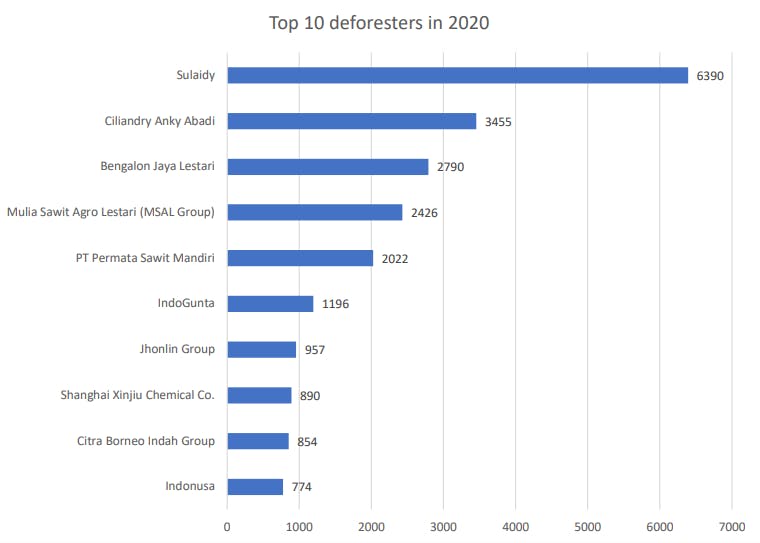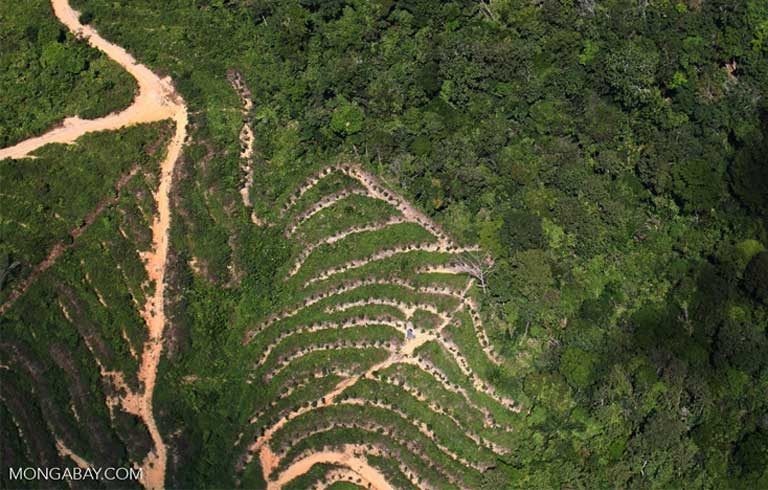- Repeat offenders dominate the 2020 list of top 10 palm oil companies responsible for palm oil-linked deforestation in Indonesia, Malaysia and Papua New Guinea, according to a new analysis.
- Some of the top deforesters are shrouded in secrecy, with scant information about them publicly available.
- Overall, 2020 saw the lowest amount of palm oil-driven deforestation in three years, likely due to the COVID-19 pandemic.
- However, a resurgent domestic market in Indonesia, coupled with rallying palm oil prices, could fuel further deforestation in 2021.
JAKARTA — Palm oil-driven deforestation is slowing down in Southeast Asia in 2020 but a handful of low-profile companies continue to drive the majority of the destruction, according to a new analysis.
Using satellite imagery, sustainability risk analysis organization Chain Reaction Research (CRR) found that 58% of the 38,000 hectares (93,900 acres) of deforestation for oil palm plantations in Indonesia, Malaysia and Papua New Guinea occurred in the concessions of 10 companies in Indonesia.
Most of these companies also appeared in the 2018 and 2019 lists of top deforesters, and their products also end up in the supply chains of major global brands with “no deforestation, no peatland, no exploitation” (NDPE) policies.
CRR said this once again highlights “both the failure of many buyers with NDPE policies to adequately implement their policies and the risk of leakage markets.”
The remaining 42% of the deforestation is distributed among 112 other companies; the top three, by contrast, are responsible for 33% of the deforestation, according to the analysis, which was coordinated by research consultancy Aidenvironment and partner organization Earth Equalizer.
Those top three companies are all owned by Indonesian families and account for a combined 12,635 hectares (31,200 acres) of deforestation, according to CRR — an area the size of 250,000 basketball courts.

The palm oil player no one’s heard of
At the top of the list are companies owned by a little-known businessman from Sumatra named Sulaidy. CRR’s analysis pinned 6,390 hectares (15,790 acres) of deforestation to six of Sulaidy’s eight oil palm plantations in eastern Borneo. This marks the third consecutive year in which Sulaidy-associated companies have ranked first among deforesters. Of the six plantations in question, PT Borneo Citra Persada Jaya in Kutai district, East Kalimantan province, contributed the largest amount of deforestation, with 1,833 hectares (4,530 acres) of forest cleared.
Despite consistently being a top deforester, there’s little public information about Sulaidy or his closely held business group. In a 2018 report, Greenpeace linked Sulaidy with Indonesia’s billionaire Fangiono family, which owns Singapore-listed First Resources conglomerate and FAP Agri, both major players in the palm oil industry.
According to the report, Sulaidy is listed as both a senior manager and a shareholder in many Fangiono family ventures.
The opaqueness of Sulaidy’s businesses suggests that the palm oil produced from the deforested land may be finding its way into the global market through major brands undetected, a practice known as market leakage.
Sulaidy doesn’t appear to own or operate any mills (none of his companies comes up on lists of direct suppliers to companies with NPDE policies), so it’s likely he sells the pam fruit to third-party mills, according to CRR. These mills then go on to supply the global brands.
A CRR investigation last year unearthed at least one such case. It found that PT Palmdale Agrosia Lestari, a Sulaidy subsidiary, was selling palm fruit to a mill owned by PT Pundi Lahan Khatulistiwa. This mill sells the processed palm oil to several companies with NDPE policies, including Danone, Kellogg’s, Mondelēz, Nestlé and Unilever — all of which have made public commitments to purge their supply chains of deforestation.
When the alleged market leakage was reported in 2020, Unilever said it had requested its suppliers to suspend all activity with Sulaidy. Danone and Nestlé said they had launched their own internal investigations and would take corrective actions if needed, with the latter adding that it didn’t find Sulaidy’s companies in the lists of companies selling palm fruit to any of its suppliers.

Shell company in a tax haven
In second spot on CRR’s list of top palm oil deforesters last year is PT Ciliandry Anky Abadi (CAA), a privately held plantation company with a 120,000-hectare (296,500-acre) land bank in Borneo’s Central Kalimantan province. CAA first appeared in the list of top deforesters in 2018, but dropped out in 2019, before making an appearance again in 2020, where it’s been linked to 3,455 hectares (8,537 acres) of deforestation in its concessions.
Like Sulaidy, CAA has been linked to the Fangiono family, whose First Resources is a significant supplier to at least 20 traders/refiners and consumer goods companies with NDPE policies. CAA itself doesn’t have any sustainability commitments, according to CRR.
A 2018 report by CRR alleges that CAA is controlled by a shell company registered in the British Virgin Islands with ownership links to Martias Fangiono, the founder of First Resources.
Both First Resources and CAA have denied the allegation, saying they are not affiliated either financially or operationally.
CRR says CAA still supplies major brands that espouse sustainability commitments, such as Johnson & Johnson, Kellogg’s, L’Oreal and Mondelēz, through its palm oil mills, PT Tirta Madu and PT Borneo Ketapang Indah.

The newcomer and the veterans
The No. 3 deforester on CRR’s list, PT Bengalon Jaya Lestari (BJL), appears there for the first time. According to CRR, BJL cleared 2,790 hectares (6,900 acres) in 2020 on concessions held by its subsidiaries, PT Kartika Nugraha Sakti and PT Wana Jaya Abadi, in North Kalimantan province.
Since there’s little publicly available information on the group and it doesn’t appear to operate palm oil mills, BJL is one of only three companies in the top 10 that can’t definitely be connected to consumer brands with NDPE policies.
A mixture of old and new names make up the rest of the list, with repeat offenders such as the Mulia Sawit Agro Lestari (MSAL) Group and Jhonlin Group making an appearance for a third straight year.
According to the analysis, MSAL cleared 2,426 hectares (6,000 acres) of forest, peat forest, and peat in its three plantations in Central Kalimantan, while Jhonlin deforested 957 hectares (2,360 acres) in 2020 after occupying the second position for two years in a row. Jhonlin was founded by influential tycoon Andi Syamsudin Arsyad, popularly known as Haji Isam, whose business ranges from palm oil to coal mining. According to CRR, both MSAL and Jhonlin’s products appear in the supply chains of major brands with NDPE policies, such as AAK, COFCO International, Oleon, General Mills, Johnson & Johnson, Kellogg’s, and PZ Cussons.

Slowdown
CRR’s report isn’t all bleak. The palm oil-linked deforestation in the three countries, at 38,000 hectares, is the lowest in three years, down from 90,000 hectares (222,400 acres) in 2019 and 74,000 hectares (182,800 acres) in 2018.
CRR attributed the slowdown to the economic slump and travel restrictions brought by the COVID-19 pandemic. According to data from Indonesia’s oil palm business association, GAPKI, production and exports of the commodity contracted in the first half of 2020, while prices slumped across commodities markets.
Palm oil production rebounded in the second half of the year, however, driven by stronger domestic demand, leading to an increase in palm oil prices.
This could spell greater deforestation, CRR warned: “Domestic demand and rallying palm oil prices may result in an upturn in land development in 2021.”
Banner image: Excavator working in an oil palm plantation in Aceh, Sumatra, Indonesia. Image by Rhett A. Butler/Mongabay.
FEEDBACK: Use this form to send a message to the author of this post. If you want to post a public comment, you can do that at the bottom of the page.
